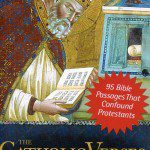¶ The Orthodox scholar, Fr. Stanley S. Harakas confirms the lateness of the tradition of divorce (some 500 years after Christ) in Eastern Christendom:
The Church is opposed to divorce in principle and sees it as a failure and an evil. However, . . . Jesus did not prohibit all divorces . . . In the year 541 a law was passed by the state (Novel 117) and was later made a ruling of both the Church and the state which recognized several reasons for divorce, all of which presupposed the breakdown of the unity of the couple, corresponding to physical death and adultery. These reasons have since become expanded somewhat, but it is always a sad and sorrowful thing for the Church to acknowledge the end of a marriage. (The Orthodox Church: 455 Questions and Answers, Minneapolis: Light & Life Pub. Co., 1987, 107)
¶ Orthodox Archbishop Kallistos (Timothy) Ware explains the Orthodox position on divorce, which to Catholic ears sounds morally incoherent:
Certainly Orthodoxy regards the marriage bond as in principle lifelong and indissoluble, and it sees the breakdown of marriage as a tragedy due to human weakness and sin. But while condemning the sin, the Church still desires to help suffering humans and to allow them a second chance. When, therefore, a marriage has entirely ceased to be a reality, the Orthodox Church does not insist on the preservation of a legal fiction. Divorce is seen as an exceptional but unavoidable concession to our human brokenness, living as we do in a fallen world . . . the Orthodox Church knows that a second alliance cannot have exactly the same character as the first; and so in the service for a second marriage several of the joyful ceremonies are omitted, and replaced by penitential prayers. In practice, however, this second marriage service is scarcely ever used. (The Orthodox Church, New York: Penguin Books, 1993 edition, 295)
¶ Eminent Protestant historian Philip Schaff, describing the Christian view of marriage in the ante-Nicene period, asserts:
It was in its nature indissoluble except in case of adultery. (History of the Christian Church, vol. 2: A.D. 100-325, Grand Rapids, Michigan: Eerdmans, 1910, 364)
Comment: Schaff may not be taking into account the Pauline privilege, the “separation of bed and board,” and the distinction between annulment and divorce; however he regards divorce, he does confirm, however, that only one justification existed, not ten, or twenty-one, as in more modern Orthodox canon law.
¶ Professor of History and Philosophy of Religion E. O. James (unstated religious persuasion) writes, in his Marriage Customs Through the Ages (New York: Collier Books, 1965, pp. 129-130, 132-133, 151-152):
Canonical legislation governing Christian marriage gradually became systematized to interpret and apply the divine law on the assumption that the sacramental contract validly made and consummated is dissoluble only by the death of one of the parties . . . . .
[the author cites the presence from the beginning of the “Pauline privilege” in terms basically synonymous with the Catholic notion of annulment – viz., that in such cases the marriage never existed]
As the Church established its position in the Empire, and eventually became the sole authority, it set to work to correct laxity of observance by the exercise of canon law through its matrimonial courts. In the Byzantine East, however, imperial control remained much more firmly entrenched and civil legislation had a stronger hold than in the West. Thus, between the time of Constantine (314) and that of Justinian (527) facilities began to be given not only for the putting away of a wife or husband for adultery (porneia) which was a generally accepted practice in the pre-Constantine period, but for remarriage after divorce, at any rate in the case of the innocent party . . .
. . . the Latin Church on the whole has maintained the most consistent and uncompromising attitude in Christendom to the indissolubility of marriage . . . How deeply laid in Western Christendom was this conception of indissolubility is shown by the refusal of theologians to grant even to the Pope the right to dissolve a validly contracted and duly consummated marriage between two baptized persons . . .
In the Byzantine Empire . . . the Church made no attempt to determine the legal aspects of the constitution of marriage. It accepted the existing civil regulations including, as we have seen, the dissolution of the union a vinculo [dissolution of the marriage bond] under certain conditions . . . no conflict has arisen between the canonical legislation of the Orthodox Church and the secular authority since the civil order was reformed by the Byzantine emperors. Even when the decisions of the ecumenical synods, including those of Trullo, have been modified by later secular legislation no opposition has been encountered from the ecclesiastical authorities, so completely has marriage become regarded as subject to State regulation.
In the Latin West, on the other hand, the traditions of the indissolubility of Christian marriage were steadfastly maintained even before matrimonial causes were brought exclusively under spiritual jurisdiction. Papal decisions like those of Gregory II (726) communicated to St. Boniface, or of Alexander III to the bishop of Amiens, could be interpreted as declarations of nullity rather than permissions granted by the popes to the Frankish kings to dissolve a valid marriage.
¶ Eastern Christendom was thus willing to forsake the advice of its own holy fathers with regard to divorce; e.g., St. John Chrysostom:
Do not cite the civil law made by outsiders, which command that a bill be issued and a divorce granted. For it is not according to these laws that the Lord will judge thee on the Last Day, but according to those which He Himself has given. (De. Lib. Rep., cited in Bertrand Conway, The Question Box, New York: Paulist Press, 1961 edition, 204)
¶ Catholic theologian Ludwig Ott summarizes the teaching of the Church fathers:
The Fathers of the first centuries almost all expound the view that in the case of adultery the dismissal of the guilty party is permitted, but that a subsequent re-marriage is forbidden [he cites Justin Martyr, Clement of Alexandria, Origen] . . . St. Basil (Ep. 188 can. 9), St. Epiphanius (Haer. 59, 4) and Ambrosiaster (on 1 Cor 7,11) in view of Mt 5,32 and 19,9, and influenced by the state of legislation, allowed the man the right to the dissolution of the marriage and to marry again in the case of adultery of the woman. A defender of the absolute indissolubility of marriage, even in the case of adultery, is St. Augustine. (Fundamentals of Catholic Dogma, Rockford, Illinois: TAN Books and Publishers, 1974 [orig. 1952], 464)
What we have seen so far is more than adequate to establish that the Catholic Church alone maintains the Tradition of the early undivided Church in the first five centuries with regard to marriage and divorce. Eastern Christendom, laboring (as is so often the case) under the false notion of caesaropapism, beginning in the 6th century, introduced innovations and corruptions of the biblical and patristic understanding of the indissolubility of the marriage bond. The Orthodox legatees of the Eastern Christian Tradition have unfortunately continued this unbiblical and untraditional practice, and expanded it — now allowing many more reasons than adultery for the dissolution of a validly-consummated marriage. The same thing holds for contraception, as briefly mentioned by Fr. Hardon above. These are two reasons why I am Catholic rather than Orthodox, because I want the entire and uncompromised teaching of the Bible and the apostles.













